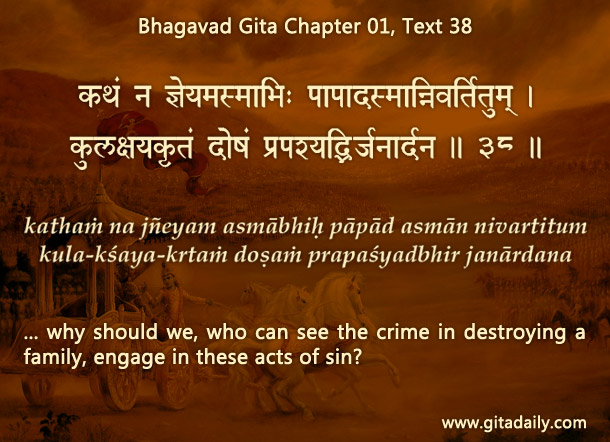‘See’ can refer literally to a physical perception and non-literally to a mental conception. Literally, we might say on spotting someone in a crowd, “I see you now.” Non-literally, we might say during a deep conversation, “I see your point.”
The theme of seeing runs throughout the Bhagavad-gita in both Arjuna’s words and Krishna’s words. It is prominent in both the chapters where Arjuna speaks the most: the first and the eleventh. In the Gita’s first chapter, Arjuna uses it in a literal sense when he wants to see his opponents (01.21: nirikshe, 01.23: avekshe). Interestingly, he also uses words related to ‘seeing’ non-literally to refer to envisioning the consequences of fighting. Conveying his far-sightedness, he states: even if the Kauravas are blinded by greed and can’t see the consequences of fighting, we can see (01.38: prapashyadbhir) — therefore, we should refrain from fighting
The entire eleventh chapter centers on Arjuna’s desire to see the universal form (11.03: drashtum, darshayatmanam). And Krishna fulfills his desire by providing him with divine eyes (11.08: divyam … chakshuh). In fact, the theme of seeing is so ubiquitous in the eleventh chapter that it is included in the chapter-name itself (seeing the universal form: vishva-rupa darshan).
Though Arjuna claims to be far-sighted (01.38), he is not far-sighted enough. One test of clear vision is confident action — if we see things properly, we know what to do and go about doing it enthusiastically. Despite his overtures about being far-sighted, Arjuna ends up confused, even paralyzed (02.06).
Fortunately, he has Krishna by his side. Krishna blesses him with the Gita’s message, thereby protecting what is working in Arjuna’s vision and providing what is lacking. He protects Arjuna’s capacity to consider the long-term consequences of his actions and he provides Arjuna a comprehensive worldview that can help him see those consequences more holistically. Thus, Krishna honors his promise given in the Gita (09.22) in the Gita itself. And he equips Arjuna with the vision necessary for doing his duty (18.73).
One-sentence summary:
Seeing literally with our eyes is a preliminary form of seeing — seeing non-literally includes seeing future ramifications with our intelligence and seeing higher aspects of reality by divine grace.
Think it over:
- How is ‘seeing’ used literally by Arjuna?
- How is ‘seeing’ used non-literally by Arjuna?
- How does Krishna complement Arjuna’s vision?
***
01.38: Why should we, who can see the crime in destroying a family, engage in these acts of sin?
To know more about this verse, please click on the image


vision is the source of vices
Yes, misdirected vision is.